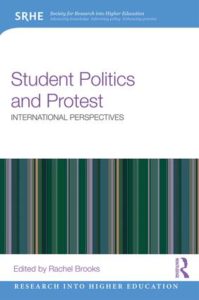The blogpost below originally appeared on the Surrey Sociology blog. However, I am re-posting it here as it relates to a paper that I’m giving at the European Conference on Educational Research this week. It is based on a cross-national project I conducted in the UK and Denmark.
Introduction
Historically, educational institutions have had an uneasy relationship with emotions. Following the Enlightenment tradition, schools and universities have often been concerned only with educating the mind, while side-lining the body[1]. Their focus has thus, traditionally, been on reason, rather than emotion. Boler argues that this privileging of the rational over the affective has acted as a means of social control, with women excluded from the ideal of reason on the basis of their supposed association with emotion and nature. Analyses of contemporary higher education have, however, suggested that recent years have witnessed a significant shift in the place of emotions within the academy. Indeed, Ecclestone and Hayes maintain that higher education has become ‘therapeutised’, evidenced through: a concern with emotionally vulnerable students and staff; the rise of degree-level therapy and counselling courses; and an emphasis on therapeutic teacher training, which has influenced the nature of learning at university. Such changes, they suggest, are not confined to higher education, or even education more generally, but have permeated many areas of social policy – underpinned by a desire on the part of policymakers to promote ‘positive psychology’.
While many scholars have been sympathetic to arguments about the individualisation and psychologisation of social problems, Ecclestone and Hayes’ wider analysis of the place of emotions with higher education has had a more critical reception. Sue Clegg, for example, has taken issue with their assertion that any recognition of the affective has the effect of infantilising students and leads to the therapeutisation of higher education. Moreover, others have pointed out that there is a long history of feminist scholarship that has argued for the role of emotions within higher education to be made more visible, exploring the impact of ‘passionate attachments’ on pedagogy, and questioning the traditional binary split between emotion and reason.
This blogpost describes research that sought to contribute to this literature on the place of emotions within higher education through exploring the experiences of one particular group: students with dependent children (i.e. ‘student-parents’). It draws on data from two different European nations – the UK and Denmark – and, within each of them, from two higher education institutions (HEIs) with different market positions (one older, higher status HEI – ‘UK Older’ or ‘Danish Older’, and one newer, lower status institution ‘UK Newer’ and ‘Danish Newer’). 68 student-parents were interviewed across the two countries.
Guilt and UK student-parents
The extant literature indicates that students within UK higher education, who are also parents of dependent children, experience a range of emotions with respect to their studies, many of which are positive. However, within the current study, the emotion that was referred to most commonly was that of guilt. This was typically discussed in relation to respondents’ relationships with their children: many believed that the time they spent on studying was time that would otherwise have been devoted to childcare, and their children may well be suffering as a result. For a smaller number of respondents, guilt was felt in relation to their studies, rather than their children, primarily because they believed they were not spending sufficient time on their degree programme. For others, guilt was felt in relation to both children and study, as the quotation below from Esma (PhD in Gender Studies, UK Newer) indicates:
I think the biggest impact probably comes down to feelings of guilt, because I feel guilty when I’m with my children and I’m not working on my PhD and I feel guilty when I’m working on my PhD and I’m not with the children.
Guilt was, however, not experienced equally across the UK sample of student-parents. Although it was a common theme amongst many of the student-mothers, it was mentioned by only one of the ten British student-fathers. The guilt experienced by the UK student-mothers can be related to the strong normative constructions of mothering within the UK. The ‘intensive mothering’ promoted by the media, the state and other significant social actors can be seen as at odds with a decision to pursue a degree programme. Intensive mothering is understood as a gendered model that encourages women to spend a significant amount of time, energy and money raising their children, and which typically requires a considerable degree of maternal self-sacrifice. By placing responsibility for poor cognitive, social and educational outcomes on the shoulders of mothers, it is argued that they are set up for failure. Indeed, evidence suggests that, as a result of these particular expectations, many mothers not only fear that they may not be doing enough for the children, but also feel guilt – for not doing all that they could, or for wanting some time for themselves. Such emotions are inevitably heightened for those trying to juggle studying alongside mothering.
Feelings of guilt (or their absence) also appeared to be patterned by the institution the students attended: guilt was much more commonly mentioned by student-parents at UK Newer than by their counterparts at UK Older. There are a number of possible explanations for this difference. Firstly, the sample of UK Older students included considerably more men than the sample at UK Newer and there are notable differences between discourses of ‘good mothering’ and ‘good fathering’. Secondly, the larger number of international students at UK Older may be significant – as perhaps those who had lived most of their life outside the UK were less susceptible to ‘intensive parenting’ discourses and/or had taken the significant decision to move abroad for higher education only after feeling completely sure of their choice. Thirdly, the greater independent financial support accessed by the UK Older students may have reduced the need to juggle childcare and study in the same way as the UK Newer students, who were often self-funding. Finally, the prestige associated with attending the highly-regarded UK Older may have mitigated any ambivalence felt at not being in paid work (for the student-fathers) or not ‘being there’ for longer (for the student-mothers).
Spatial differentiation: the evidence from Denmark
Implicit (and sometimes explicit) in much of the work on mothering and student-mothers is an assumption that experiences are common across nation-states (or at least across those of the Global North). However, the current research with student-parents in the UK and Denmark revealed significant differences across national borders. Feelings of guilt were much less common amongst the Danish students than amongst their British counterparts.
This suggests that emotions are differentiated, not only by social characteristics such as gender, as discussed above, but also spatially – in this case, by nation state.
Diane Reay has argued that emotional responses to education (such as anxiety and defensiveness) often follow from making what is felt to be a non-normative choice. The significant differences in normative behaviour between the UK and Denmark, in relevant areas, would suggest that this thesis may help to explain the differences in feelings of guilt across the two national contexts. Within Denmark, the level of female employment is high and it is common for mothers to return to full-time work when their children are young. As a result, there is little societal disapproval of mothers working outside the home. Moreover, despite dominant discourses that reiterate the importance of ‘intensive mothering’ elsewhere in Europe and beyond, within Denmark many still believe that the state plays an important role in childrearing, evidenced through the large number of state-subsidised nurseries across the country. Within this context, it seems likely that student-mothers feel much less pressure to be physically present throughout the day for their children, and thus do not experience feelings of guilt when they choose to study for a degree. Indeed, if student-mothers see the alternative to studying as being in paid employment (rather than being at home with their children), it is likely that they will believe that, if anything, their children are benefitting from their current situation. Within the UK, however, few student-mothers saw the alternative to studying as being in full-time employment; thus, the comparisons they drew were different.
Differences in gender relations within the two nations may also help to explain the variations in emotional response. Male partners of Danish student-mothers appeared to view studying as an intrinsically worthwhile activity, and were supportive of it in a variety of practical ways. Often this support also included taking responsibility for childcare – a practice that was rarely seen amongst the partners of the British student-mothers. This accords with other studies that have shown that while, in all countries, women do more domestic and caring work, men in Nordic nations are much more involved in childcare than their peers in the UK and other European countries. Thus, within a context in which male partners are willing, able and expected to share childcare, it is perhaps unsurprising that student-mothers do not feel guilt at combining study with raising a family.
Concluding thoughts
By drawing on the narratives of higher education students with dependent children studying in the UK and in Denmark, the research on which this blogpost draws provides evidence of the way in which the production of one particular emotion (guilt) is inextricably linked to social locations and spatial contexts. It has argues that feelings of guilt, on the part of student-parents, are influenced by a number of social characteristics, most notably, gender: of those studying at UK universities, the student-mothers were much more likely to report having felt guilty about combining study and childcare than the student-fathers. It also shows that there are important variations by space – between the two UK universities in the sample and between British student-parents and those in Denmark. Thus, while emotion is often theorised as a personal and individual experience, this research underlines the socially-constructed nature of emotional responses.
If you would like to read more about this research, do have a look at this article, published in the British Educational Research Journal.
[1] There is also, however, a large literature on how schools and other educational institutions ‘discipline’ the body.

 Call for Papers: Symposium on ‘Constructing the higher education student: understanding spatial variations’, Royal Geographical Society-Institute of British Geographers Annual Conference, 29th August-1st September 2017
Call for Papers: Symposium on ‘Constructing the higher education student: understanding spatial variations’, Royal Geographical Society-Institute of British Geographers Annual Conference, 29th August-1st September 2017 Student Politics and Protest: International Perspectives
Student Politics and Protest: International Perspectives In the literature on higher education, there is an increasing emphasis on the importance of virtual spaces in terms of both pedagogic practice and wider aspects of university life. It has also been argued that online spaces, and social media in particular, are playing a key role in facilitating the political engagement of students. In our research on contemporary students’ unions, however, much greater emphasis was placed by our respondents (students’ union officials and senior institutional managers) upon the physical spaces of the campus than on the virtual spaces available to students and/or students’ union officials for both academic and social activities. Indeed, the students’ union building itself was discussed, at great length, by many of the students’ union officials and senior managers who participated in our focus groups. Several respondents described how changes had recently been made to the buildings used by the students’ union, which, they claimed, had had a positive effect. For senior managers at one of our higher education institutions (HEIs), for example, a shift to a more central location on campus was thought to have had a significant influence on the visibility of the union, and the propensity of others to engage with it:
In the literature on higher education, there is an increasing emphasis on the importance of virtual spaces in terms of both pedagogic practice and wider aspects of university life. It has also been argued that online spaces, and social media in particular, are playing a key role in facilitating the political engagement of students. In our research on contemporary students’ unions, however, much greater emphasis was placed by our respondents (students’ union officials and senior institutional managers) upon the physical spaces of the campus than on the virtual spaces available to students and/or students’ union officials for both academic and social activities. Indeed, the students’ union building itself was discussed, at great length, by many of the students’ union officials and senior managers who participated in our focus groups. Several respondents described how changes had recently been made to the buildings used by the students’ union, which, they claimed, had had a positive effect. For senior managers at one of our higher education institutions (HEIs), for example, a shift to a more central location on campus was thought to have had a significant influence on the visibility of the union, and the propensity of others to engage with it: